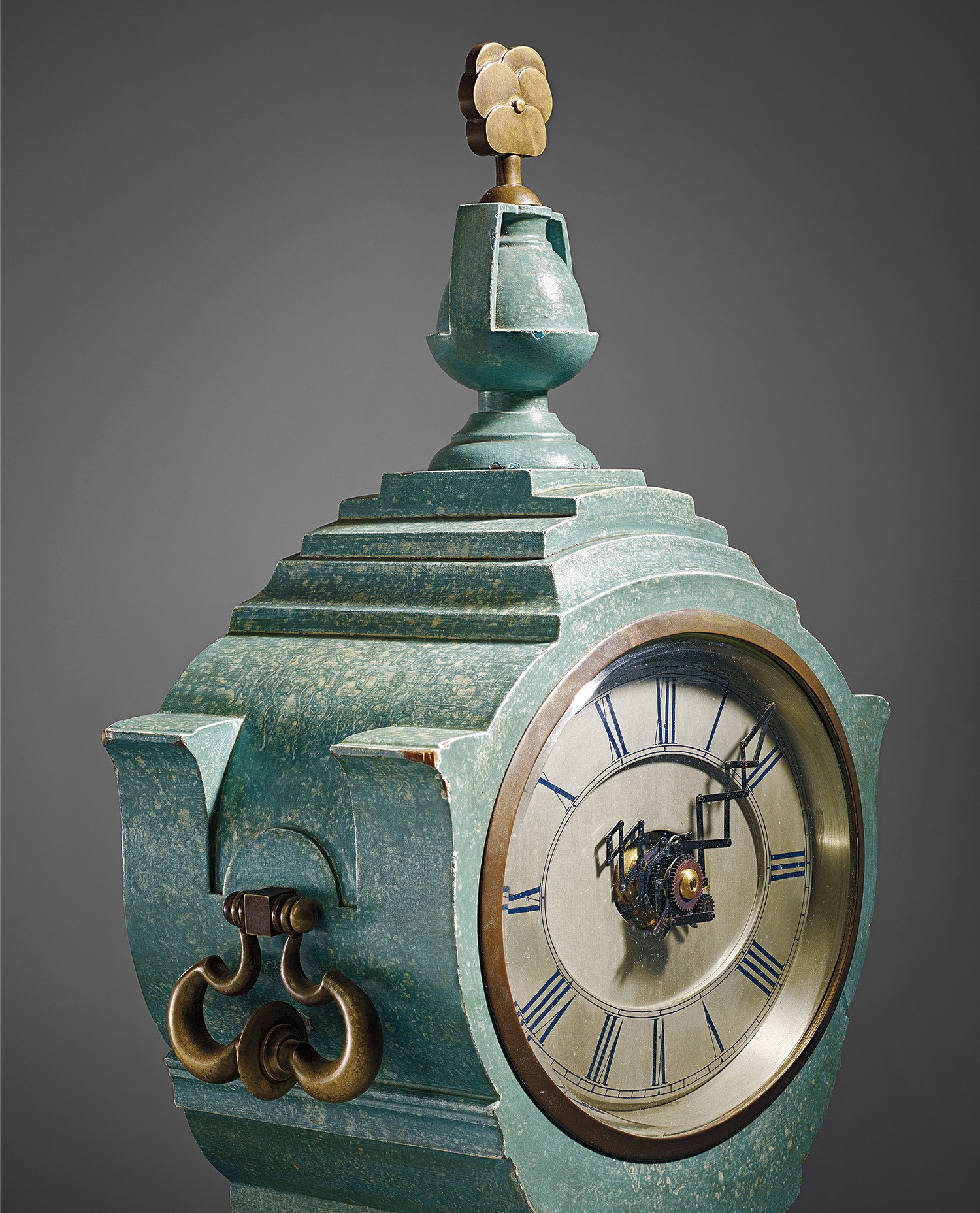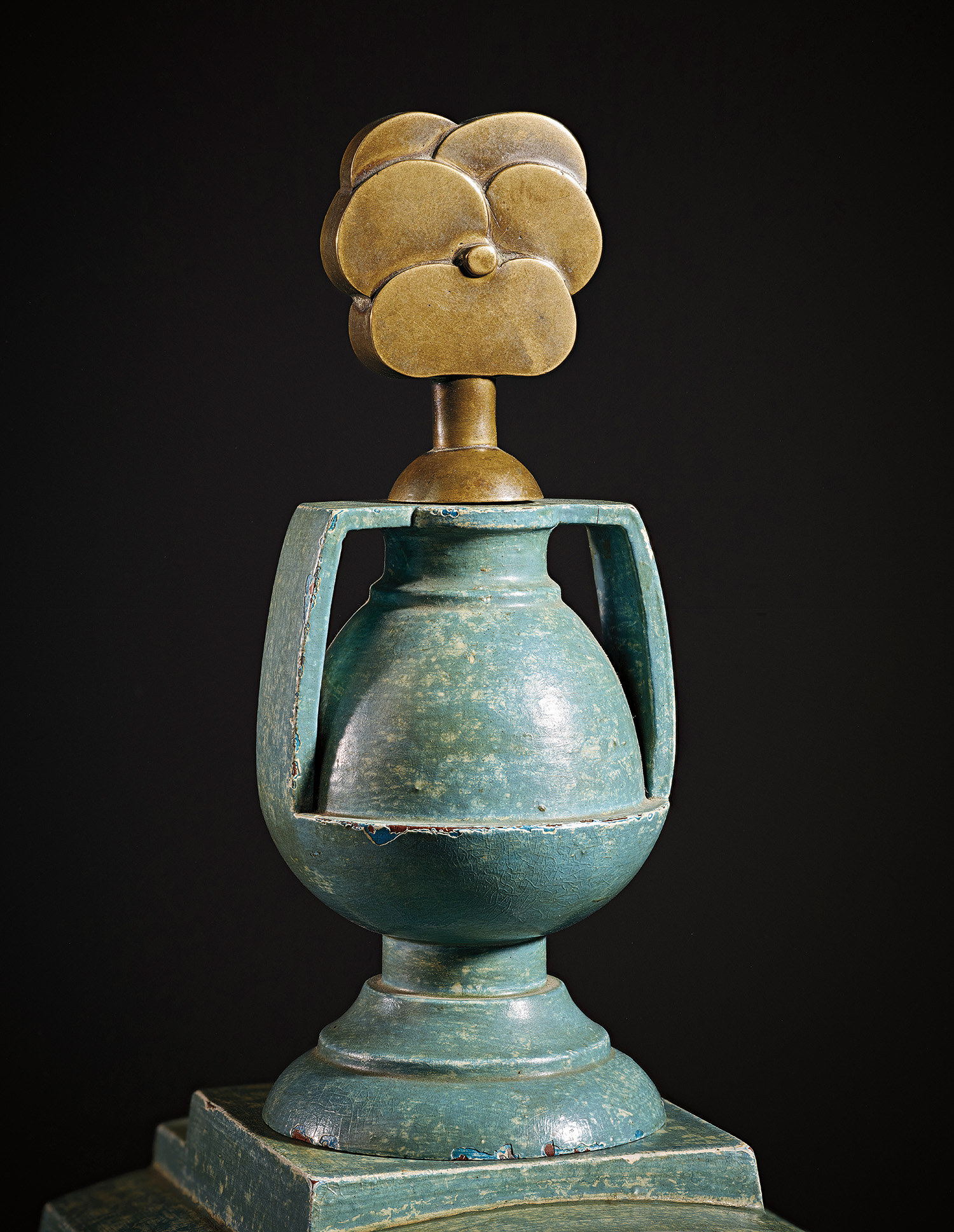





Property from the Lutyens Family Estate
91
Sir Edwin Lutyens
Important and rare Mantel clock, designed for Lady Willingdon, the Viceroy’s House, New Delhi
circa 1930
Painted mahogany, brass, glass.
42.5 x 22 x 15.5 cm (16 3/4 x 8 5/8 x 6 1/8 in.)
Full-Cataloguing
Sir Edwin Lutyens - The Viceroy's House Clock
Sir Edwin Lutyens was the greatest British architect of the first half of the twentieth century. Stylistically, he moved from the modernised vernacular of his country houses of the 1890s to the full-blown classicism of the later Edwardian period, but whatever his sources, whether Surrey farmhouses, Palladio or Wren, they were synthesised into something uniquely Lutyens, often suffused with wit. Even so great a project as the Viceroy’s House in New Delhi (1913 onwards) could employ humour and whimsy in its fittings in contrast to the grandeur of the architecture. The chandeliers in the nurseries are particularly famous examples. The Day Nursery has hens, while below them hanging broken egg shells, the light bulbs being the yolks, whilst the Night Nursery has praying angels to guard against nightmares. In the Drawings Collection of the Royal Institute of British Architects is a design for a Nursery wall clock in the form of a bewigged footman, his face being the dial and his eyes the holes for winding him up.
Another example is the mantel clock that Lutyens designed for Lady Willingdon, whose husband became Viceroy of India (1931-36) the year that New Delhi was inaugurated as the capital of British India. The clock takes the form of an urn surmounted by a vase finial supporting a flower. This is actually a brass key cast as a pansy, by family tradition a pun on the French word penser, a reminder to wind it up. Lutyens was famous for his bad puns. The oval clock face requires hands that expand and contract like tongs to ensure that the time can be read accurately.
The Willingdons were the first viceregal couple to occupy the new Viceroy’s House, so although Lutyens’s official duties as architect were completed, he continued to work on the furniture and fittings. Indeed, it is remarkable how much he continued to be involved in designing even relatively small elements of furnishings for the great building. It is likely that the clock was designed early in the new viceroyalty, probably 1931-1932. The architect’s views on the Vicereine were mixed. He had met her in England, which is probably why he was invited to dinner in Bombay in 1913, Lord Willingdon having been appointed Governor that year. She upset Lutyens somewhat by criticising the shabbiness of his evening clothes. He called her to his wife as ‘very brusque and in her way rude’. Lutyens’s great-grand-daughter Jane Ridley described her as ‘combining bad manners with worse taste’. As Vicereine, she caused considerable trouble to him and his staff by interfering in the decoration of the Viceroy’s House (she had a passion for mauve and insisted on its use everywhere possible), as well as in the continuing development of New Delhi. Ridley also comments that one of her worst crimes was blocking a carefully planned vista from the Viceroy’s House with a stadium dedicated to her and her husband. Lutyens had to go back to New Delhi in 1938 to repair the damage that she had done in his masterpiece.
History unfortunately does not relate what Lady Willingdon thought of her clock. Its present location is unknown. Although Lutyens designed a great deal of the furniture and objects for Viceroy’s House, most of them are no longer in situ and many items are no longer there at all. Although it is possible Lady Willingdon brought the clock back to England in 1936, it is more likely that it is amongst the items that have disappeared since 1948. As was his wont when he was particularly pleased with a design, Lutyens commissioned one or two copies for himself and his family (a second clock remains with another descendant). The present lot can be seen sitting at Lutyens's desk in a photograph of the late 1930s.
By Charles Hind
Chief Curator and H.J. Heinz Curator of Drawings,
Royal Institute of British Architects
Sir Edwin Lutyens was the greatest British architect of the first half of the twentieth century. Stylistically, he moved from the modernised vernacular of his country houses of the 1890s to the full-blown classicism of the later Edwardian period, but whatever his sources, whether Surrey farmhouses, Palladio or Wren, they were synthesised into something uniquely Lutyens, often suffused with wit. Even so great a project as the Viceroy’s House in New Delhi (1913 onwards) could employ humour and whimsy in its fittings in contrast to the grandeur of the architecture. The chandeliers in the nurseries are particularly famous examples. The Day Nursery has hens, while below them hanging broken egg shells, the light bulbs being the yolks, whilst the Night Nursery has praying angels to guard against nightmares. In the Drawings Collection of the Royal Institute of British Architects is a design for a Nursery wall clock in the form of a bewigged footman, his face being the dial and his eyes the holes for winding him up.
Another example is the mantel clock that Lutyens designed for Lady Willingdon, whose husband became Viceroy of India (1931-36) the year that New Delhi was inaugurated as the capital of British India. The clock takes the form of an urn surmounted by a vase finial supporting a flower. This is actually a brass key cast as a pansy, by family tradition a pun on the French word penser, a reminder to wind it up. Lutyens was famous for his bad puns. The oval clock face requires hands that expand and contract like tongs to ensure that the time can be read accurately.
The Willingdons were the first viceregal couple to occupy the new Viceroy’s House, so although Lutyens’s official duties as architect were completed, he continued to work on the furniture and fittings. Indeed, it is remarkable how much he continued to be involved in designing even relatively small elements of furnishings for the great building. It is likely that the clock was designed early in the new viceroyalty, probably 1931-1932. The architect’s views on the Vicereine were mixed. He had met her in England, which is probably why he was invited to dinner in Bombay in 1913, Lord Willingdon having been appointed Governor that year. She upset Lutyens somewhat by criticising the shabbiness of his evening clothes. He called her to his wife as ‘very brusque and in her way rude’. Lutyens’s great-grand-daughter Jane Ridley described her as ‘combining bad manners with worse taste’. As Vicereine, she caused considerable trouble to him and his staff by interfering in the decoration of the Viceroy’s House (she had a passion for mauve and insisted on its use everywhere possible), as well as in the continuing development of New Delhi. Ridley also comments that one of her worst crimes was blocking a carefully planned vista from the Viceroy’s House with a stadium dedicated to her and her husband. Lutyens had to go back to New Delhi in 1938 to repair the damage that she had done in his masterpiece.
History unfortunately does not relate what Lady Willingdon thought of her clock. Its present location is unknown. Although Lutyens designed a great deal of the furniture and objects for Viceroy’s House, most of them are no longer in situ and many items are no longer there at all. Although it is possible Lady Willingdon brought the clock back to England in 1936, it is more likely that it is amongst the items that have disappeared since 1948. As was his wont when he was particularly pleased with a design, Lutyens commissioned one or two copies for himself and his family (a second clock remains with another descendant). The present lot can be seen sitting at Lutyens's desk in a photograph of the late 1930s.
By Charles Hind
Chief Curator and H.J. Heinz Curator of Drawings,
Royal Institute of British Architects